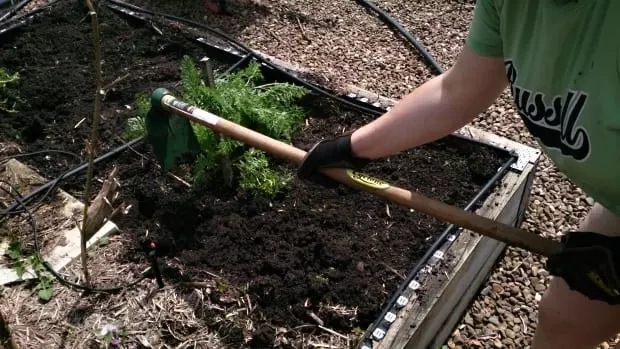Every climate and food garden has a particular time of year – a window of opportunity – when growing food is at its best. It’s extremely important to know when the beginning of this growing window is in your location; because, if you miss this window of growing opportunity it can set your food growing, and thus production, back severely for the coming six months.
Within this window of opportunity you must be focused in the garden with your head down and bum up manically doing what you have to do and letting nothing distract you from your mission. What you do now in this small window of opportunity in your garden will lay the foundation for productive and successful plants all through the main growing season and possibly future crops for years to come (if you grow heirloom plants and collect your own seeds).

Hoe, hoe, hoe… Time to de-weed and fluff that soil up for the new season (above image)
You need to dedicate this term to your garden and nothing else! Forgo the spur of the moment weekend events and the self-indulgent “me-time” weekends off, and put all your energy into the garden. Sure, you’ll have to attend some “compulsory” functions and appointments but if you can avoid them during this special period then do so and spend the time in your garden instead.
How long is the window?
You have about 4 weeks (from my experience and generally speaking) to make the best use of the “perfect growing storm” before the growing opportunity significantly wains.
Don’t look at that pack of seeds reading “sow all year” and think you’re safe… that’s bull! The truth is no matter where you live in the world you have 1 month to shape the next 11 months in your garden and if you nail it you’ll be buried neck deep in fresh produce and be the talk of the neighbourhood – how does she/he do it?
Type of plant
Of course, this growing window can be more or less desperate depending on the type of food plant or crop. For instance, a crop of lettuce (non-hearting) can grow rather quickly and therefore can be “saved” if it’s planted late; however, a tomato bush usually needs a good three months to mature and planting too late can mean disaster. Knowing the time to maturity of your food crops is important because you can waste a lot of time and energy through planting crops too late in the season and having a situation where they grow well only to fail at the food producing end.
And, the same can be said for planting too early (preempting the window of opportunity) without the right forethought and protection (like a green/hot house). Yes, if you want to circumvent your natural window of growing opportunity then you’ll want to be prepared or you’ll pay the consequences.

The vast majority of backyard vegetables, or other food crops, can be planted around the same time with some exceptions. The image above was taken mid-autumn in our sub-tropical climate. Strawberries, artichokes, sweet potato in foreground, followed by purple basil, snake and Madagascan beans in the background.
When is the best "window of growing opportunity" in your part of the world?
The best "window of growing opportunity" in your part of the world is something you need to work out for yourself. Every climate is different, the same climate zone in a different part of the world is different, and the micro-climate from region to region and even neighbour to neighbour is different, and can make a big difference.
Simplistically speaking, a tropical climate may have a window of growing opportunity starting a few weeks into the dry season, a temperate climate could have it bang on Spring, and a cold climate might start mid-spring.

A frozen allotment vegetable garden (image above) there's not a lot you can grow at this time of year in this climate.
In my climate (subtropical) (inland) (sea level) (surrounded by structure and large trees) my perfect growing window of opportunity is mid-Autumn. At that time, we’re finally out of the hot, humid, wet season; even though, the rains should have finished by the start of Autumn. But often, the rains hang around into Autumn making gardening difficult – hence the hold-off.
Not that we can’t grow anything at any other time of the year, it’s just that our optimal growing season here is end-Autumn through to end of spring. Therefore, to get the best out of those 6 months we need to ensure our prep is done and dusted by week 10 of Autumn. Meaning, our perfect window of growing opportunity starts at week 6 and goes to week 10 (4 weeks).
However, this growing window can and does change – not usually by too much but it can be a few weeks. Things like abnormally long or shorter wet or cold seasons will affect the growing window and this is what I mean by getting to know and feel your garden over several seasons so you can adjust and do the bulk of your prep-growing to get the best out of the coming season.
What to do in the window of growing opportunity?
Generally, EVERYTHING to do with growing gets done in this 4 week period to set-up for the whole year. I’ll concede in some cases some of these tasks can be done earlier or concurrently throughout the actual growing season but the following is a non-exhaustive list of what needs to be done:
- Garden beds – Whether they be natural or constructed using materials, it's not always easy to fix and build growing beds in the off-season (especially in the more extreme climates) so use this period now to get the garden beds up to speed.

Three square raised vegetable beds all refurbished and ready to go. Having several similar garden beds not only gives more space it also makes crop rotation easier which helps prevent the build-up of soil diseases (image above)
-
Fertilising – It’s a good time to replenish the soil nutrients to ensure the food crops have food themselves to thrive and grow.
-
Soil improvement – Check the soil structure and add organic matter if needed.
-
Mulching – This is very important not only for soil protection or water retention but also to suppress weeds and encourage microbes or worms to thrive.

A well mulched garden bed with a simple riser watering system is inexpensive and easy to do (image above)
-
Watering systems – Flush out, check filters, make new lines, etc.
-
Pest protection – To cover seedlings from insect and animal attack (if required).
-
Growing structures (trellises) – Get them in place where needed.

Trellises don't have to be big structures a mini trellis like the one above made from reo-mesh and a star picket is cheap, easy, but effective.
-
Sowing seeds – Plan where certain plants are to be grown, sow seeds directly or in trays as needed. Have a succession sowing plan in place (space, timing).

-
Planting out seedlings – Get crops with a longer growing season into the ground ASAP so they mature on time. Get fast growing crops established for an early start to the season.
-
Dividing/re-potting – divide perennials and prune (if appropriate) to take advantage of the growing season. Check pot mediums if depleted re-pot.
Conclusion
I know in most places around the world gardens need to be tended all year round – that’s a given. Nevertheless, if the right prep is not done at the right time (the window of growing opportunity) you may find the tendering is mainly to pull weeds and not food from your garden beds.
Study your climate and feel the right time in your part of the world to set-up your food garden for success. Then seize the opportunity and work like a mad dog for those four weeks so you can reap the rewards for the next 11 months… It’s surely worth the effort.
If you like this post be sure to share it around using the social buttons on the page (it helps).
Would you be interested in talking more about growing food? Why not join our online community @ Self Sufficient Culture; also, you can make a comment in the area below (your email is not required).
Thanks for visiting SSM and thanks for your support!
Mark Valencia – Editor SSM
Look, and see the Earth through Her eyes…














